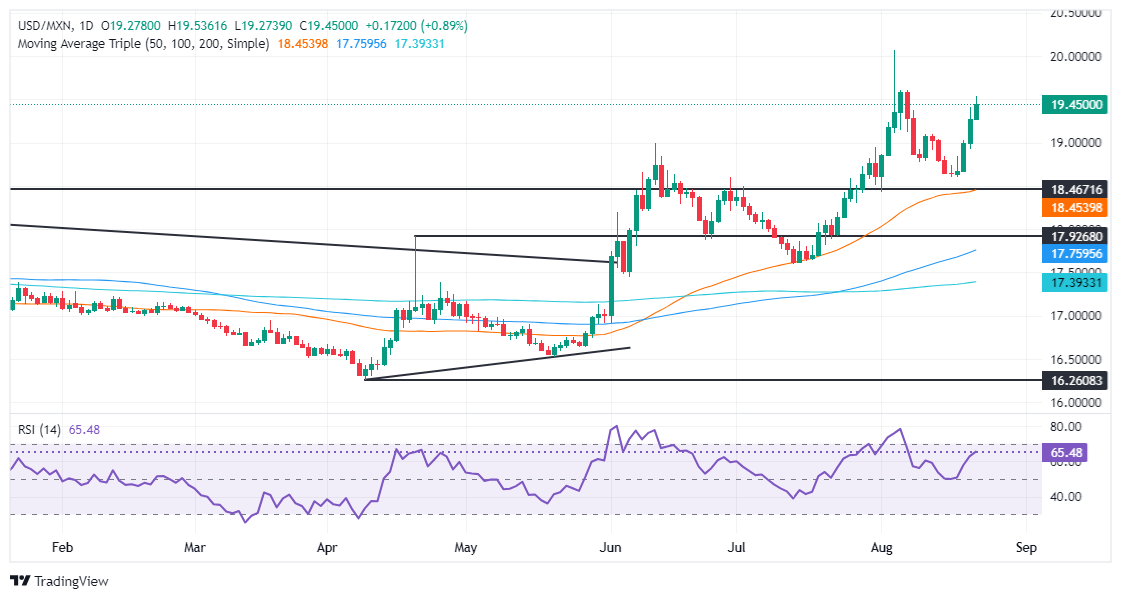Most recent article: Mexican Peso bottoms out after losing an average of 5% in key pairs
- Mexican Peso extends losses, pressured by inflation still above Banxico's 2-4% goal despite recent declines.
- Economic data shows deceleration in Mexico’s GDP, hinting at potential for further rate adjustments by Banxico.
- US Dollar strengthens amid strong labor market data and Fed officials signaling potential rate cuts in September.
The Mexican Peso prolonged its agony and extended its losses to four straight days against the Greenback after data showed that inflation is coming down; but it remains above the Bank of Mexico’s (Banxico) 2 to 4% goal. The US Dollar appreciates against most currencies amid mixed economic data, yet the USD/MXN trades at 19.42 and gains 0.81%.
The USD/MXN bounced off daily lows of 19.24 as the Instituto Nacional de Estadistica Geografia e Informatica (INEGI) revealed that August’s mid-month headline and core inflation dropped. This could warrant another Banxico adjustment to its main reference rate following the August 8 meeting.
Other data showed the economy is decelerating. The Gross Domestic Product (GDP) for the second quarter of 2024 ticked lower on an annual basis yet remains above the 2% threshold.
In the meantime, Banxico revealed its latest meeting minutes. On August 8, the central bank lowered rates to 10.75% in a split decision. The minutes showed that even though “the inflation outlook still calls for a restrictive monetary policy,” the “significant progress” on inflation suggested it was adequate to “reduce the level of monetary restriction.”
Jonathan Heath and Irene Espinosa, deputy governors voting against the decision to cut rates, expressed fears that jeopardizing the credibility of the Mexican central bank would be detrimental.
Across the border, the US economic docket revealed that the labor market remains strong despite cooling. While S&P Global PMIs were mixed, they showed that the economy in the services sector remains strong.
Meanwhile, Federal Reserve (Fed) officials crossed the newswires, led by Susan Collins of the Boston Fed. She said that it would soon be appropriate to cut interest rates, adding that the labor market remains strong. Echoing her comments was Philadelphia Fed President Patrick Harker, who added they should ease policy in a slow and methodical approach and support a cut in the upcoming September meeting.
Ahead of the day, Banxico will release its August meeting minutes.
Daily digest market movers: Mexico Peso depreciates as economy remains tepid
- Mexico’s GDP in Q2 2024 was 2.1%, below estimates of 2.2% YoY, yet improved from Q1's 1.6% growth.
- August mid-month inflation rose by 5.16% YoY, below estimates of 5.31%, and July’s 5.61% increase. Core figures ticked below the 4% threshold, from 4.02% to 3.98% YoY and beneath expectations for a 4.06% increase.
- US Initial Jobless Claims for the week ending August 17 rose by 232K and exceeded expectations of 230K, compared to a 228K jump the previous week.
- In August, the S&P Global Manufacturing PMI contracted for the second straight month from 49.6 to 48.0. The Services PMI expanded from 55.0 to 55.2, exceeding estimates of 54.0.
- US Existing Home Sales grew 1.3%, as expected, in August, from 3.9 million to 3.95 million.
Technical outlook: Mexican Peso pressured as USD/MXN climbs toward 19.50
The USD/MXN uptrend remains intact, yet traders face key resistance. Although momentum favors further upside as depicted by the Relative Strength Index (RSI), the pair needs to clear the psychological 19.50 figure. If that level is surpassed, the Peso could lose additional ground, as the exotic pair could aim toward 20.00, followed by the year-to-date (YTD) high of 20.22.
Conversely, if USD/MXN drops below 19.00, sellers could enter the market and drive the exchange rate toward the 50-day Simple Moving Average (SMA) at 18.48. Further losses are seen once the pair slumps below 18.00, challenging the 100-day SMA at 17.75.
Mexican Peso FAQs
The Mexican Peso (MXN) is the most traded currency among its Latin American peers. Its value is broadly determined by the performance of the Mexican economy, the country’s central bank’s policy, the amount of foreign investment in the country and even the levels of remittances sent by Mexicans who live abroad, particularly in the United States. Geopolitical trends can also move MXN: for example, the process of nearshoring – or the decision by some firms to relocate manufacturing capacity and supply chains closer to their home countries – is also seen as a catalyst for the Mexican currency as the country is considered a key manufacturing hub in the American continent. Another catalyst for MXN is Oil prices as Mexico is a key exporter of the commodity.
The main objective of Mexico’s central bank, also known as Banxico, is to maintain inflation at low and stable levels (at or close to its target of 3%, the midpoint in a tolerance band of between 2% and 4%). To this end, the bank sets an appropriate level of interest rates. When inflation is too high, Banxico will attempt to tame it by raising interest rates, making it more expensive for households and businesses to borrow money, thus cooling demand and the overall economy. Higher interest rates are generally positive for the Mexican Peso (MXN) as they lead to higher yields, making the country a more attractive place for investors. On the contrary, lower interest rates tend to weaken MXN.
Macroeconomic data releases are key to assess the state of the economy and can have an impact on the Mexican Peso (MXN) valuation. A strong Mexican economy, based on high economic growth, low unemployment and high confidence is good for MXN. Not only does it attract more foreign investment but it may encourage the Bank of Mexico (Banxico) to increase interest rates, particularly if this strength comes together with elevated inflation. However, if economic data is weak, MXN is likely to depreciate.
As an emerging-market currency, the Mexican Peso (MXN) tends to strive during risk-on periods, or when investors perceive that broader market risks are low and thus are eager to engage with investments that carry a higher risk. Conversely, MXN tends to weaken at times of market turbulence or economic uncertainty as investors tend to sell higher-risk assets and flee to the more-stable safe havens.
Information on these pages contains forward-looking statements that involve risks and uncertainties. Markets and instruments profiled on this page are for informational purposes only and should not in any way come across as a recommendation to buy or sell in these assets. You should do your own thorough research before making any investment decisions. FXStreet does not in any way guarantee that this information is free from mistakes, errors, or material misstatements. It also does not guarantee that this information is of a timely nature. Investing in Open Markets involves a great deal of risk, including the loss of all or a portion of your investment, as well as emotional distress. All risks, losses and costs associated with investing, including total loss of principal, are your responsibility. The views and opinions expressed in this article are those of the authors and do not necessarily reflect the official policy or position of FXStreet nor its advertisers. The author will not be held responsible for information that is found at the end of links posted on this page.
If not otherwise explicitly mentioned in the body of the article, at the time of writing, the author has no position in any stock mentioned in this article and no business relationship with any company mentioned. The author has not received compensation for writing this article, other than from FXStreet.
FXStreet and the author do not provide personalized recommendations. The author makes no representations as to the accuracy, completeness, or suitability of this information. FXStreet and the author will not be liable for any errors, omissions or any losses, injuries or damages arising from this information and its display or use. Errors and omissions excepted.
The author and FXStreet are not registered investment advisors and nothing in this article is intended to be investment advice.
Recommended content
Editors’ Picks

EUR/USD stays pressured near 1.1350 on USD rebound
EUR/USD trades in negative territory at around 1.1350 on Friday. Renewed US Dollar strength on growing optimism surrounding the US-China trade war de-escalation keeps the pair undermined. Trade talks and US data remain in focus.

GBP/USD consolidates losses near 1.3300 after UK Retail Sales data
GBP/USD remains under moderate selling pressure near 1.3300 despite the upbeat UK Retail Sales data for March. The pair feels the heat of the solid US Dollar rebound, aided by a Bloomberg report, which indicated China may suspend its 125% tariff on select US imports.

Gold drops below $3,300 as market mood improves
Gold turns south following Thursday's rebound and trades below $3,300 on Friday. The move down comes amid growing optimism about a de-escalation of the US-China trade conflict after US President Trump hinted at the beginning of negotiations.

Ethereum: Accumulation addresses grab 1.11 million ETH as bullish momentum rises
Ethereum saw a 1% decline on Friday as sellers dominated exchange activity in the past 24 hours. Despite the recent selling, increased inflows into accumulation addresses and declining net taker volume show a gradual return of bullish momentum.

Five fundamentals for the week: Traders confront the trade war, important surveys, key Fed speech Premium
Will the US strike a trade deal with Japan? That would be positive progress. However, recent developments are not that positive, and there's only one certainty: headlines will dominate markets. Fresh US economic data is also of interest.

The Best brokers to trade EUR/USD
SPONSORED Discover the top brokers for trading EUR/USD in 2025. Our list features brokers with competitive spreads, fast execution, and powerful platforms. Whether you're a beginner or an expert, find the right partner to navigate the dynamic Forex market.




